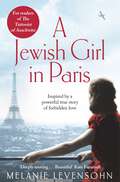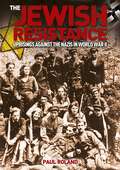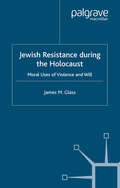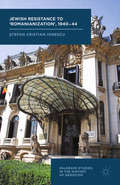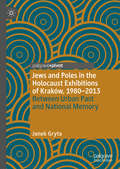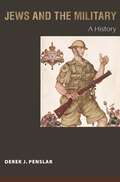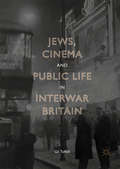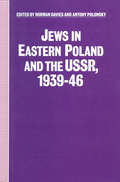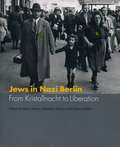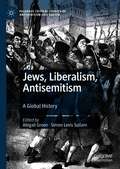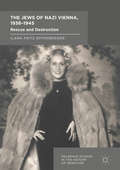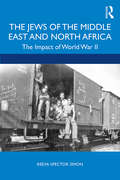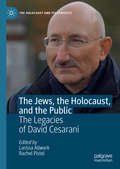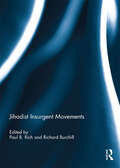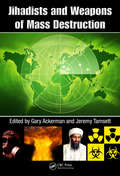- Table View
- List View
A Jewish Girl in Paris: The heart-breaking and uplifting novel, inspired by an incredible true story
by Melanie LevensohnParis, 1940, a city under German occupation. A young Jewish girl, Judith, meets a young man, Christian. But he is the son of a wealthy banker and Nazi sympathizer – his family will never approve of the girl he has fallen in love with. As the Germans impose more and more restrictions on Jewish Parisians, the couple secretly plan to flee the country. But before they can make their escape, Judith disappears . . .Montréal, 1982. Shortly before his death, Lica Grunberg confesses to his daughter, Jacobina, that she has an older half-sister, Judith. Lica escaped the Nazis but lost all contact with his first-born daughter. Jacobina promises her father to find the sister she never knew. The search languishes for years, until Jacobina is spurred on by her young friend Béatrice.Soon the two women discover a dark family secret, stretching over two continents and six decades, that will change their lives for ever . . .Inspired by true events and set against the backdrop of the Second World War, Melanie Levensohn’s A Jewish Girl in Paris is a powerful novel about forbidden love, adapted from a translation by Jamie Lee Searle.
The Jewish Legion during the First World War
by M. WattsIn the autumn of 1917, the British government established three batallions of infantry, for the reception of non-nationalized Russian Jews. Known colloquially as the Jewish Legion, the batallions served in Egypt and Palestine, before their eventual disbandment in the late spring of 1921. By drawing on the testimonies of over 600 veterans, this unique unit is analyzed from within its political and social context, thus providing fresh insights into Anglo-Jewish relations during the early twentieth century.
The Jewish Resistance: Uprisings against the Nazis in World War II
by Paul RolandThreatened with extermination, many Jewish people refused to go passively to their deaths at the hands of the Nazis during World War II and instead put up heroic resistance. Prisoners at Sobibór and Treblinka organized successful revolts, while at Auschwitz they sacrificed their lives to dynamite the crematorium.Beyond the barbed wire of the camps, hundreds of Jewish people were active in the French resistance and thousands fought with partisans in other occupied countries. One and a half million more served in the Allied armed forces. Incredibly, it took the Nazis longer to subdue the forces of the Warsaw ghetto than it had taken them to defeat the Polish army in 1939. This book reveals a little known chapter of history and uncovers many stories of amazing courage in the face of overwhelming odds.
Jewish Resistance During the Holocaust: Moral Uses of Violence and Will
by J. GlassIt is a common belief that Jews did nothing to resist their own fate in the Holocaust. However, the realities of disintegrating physical and psychological conditions, and the efforts of ghetto undergrounds to counter collaborationist judenrat policies and the despair, could not but lead to a breakdown in spiritual life.
Jewish Resistance to ‘Romanianization’, 1940-44 (Palgrave Studies in the History of Genocide)
by S. IonescuIonescu examines the process of economic Romanianization of Bucharest during the Antonescu regime that targeted the property, jobs, and businesses of local Jews and Roma/Gypsies and their legal resistance strategies to such an unjust policy.
Jewish Volunteers, the International Brigades and the Spanish Civil War (War, Culture and Society)
by Gerben ZaagsmaJewish Volunteers, the International Brigades and the Spanish Civil War discusses the participation of volunteers of Jewish descent in the International Brigades during the Spanish Civil War, focusing particularly on the establishment of the Naftali Botwin Company, a Jewish military unit that was created in the Polish Dombrowski Brigade. Gerben Zaagsma analyses the symbolic meaning of the participation of Jewish volunteers and the Botwin Company both during and after the civil war. He puts this participation in the broader context of Jewish involvement in the left and Jewish/non-Jewish relations in the communist movement and beyond. To this end, the book examines representations of Jewish volunteers in the Parisian Yiddish press (both communist and non-communist). In addition, it analyses the various ways in which Jewish volunteers and the Botwin Company have been commemorated after WWII, tracing how discourses about Jewish volunteers became decisively shaped by post-Holocaust debates on Jewish responses to fascism and Nazism, and discusses claims that Jewish volunteers can be seen as 'the first Jews to resist Hitler with arms'.
Jewish Volunteers, the International Brigades and the Spanish Civil War (War, Culture and Society)
by Gerben ZaagsmaJewish Volunteers, the International Brigades and the Spanish Civil War discusses the participation of volunteers of Jewish descent in the International Brigades during the Spanish Civil War, focusing particularly on the establishment of the Naftali Botwin Company, a Jewish military unit that was created in the Polish Dombrowski Brigade. Gerben Zaagsma analyses the symbolic meaning of the participation of Jewish volunteers and the Botwin Company both during and after the civil war. He puts this participation in the broader context of Jewish involvement in the left and Jewish/non-Jewish relations in the communist movement and beyond. To this end, the book examines representations of Jewish volunteers in the Parisian Yiddish press (both communist and non-communist). In addition, it analyses the various ways in which Jewish volunteers and the Botwin Company have been commemorated after WWII, tracing how discourses about Jewish volunteers became decisively shaped by post-Holocaust debates on Jewish responses to fascism and Nazism, and discusses claims that Jewish volunteers can be seen as 'the first Jews to resist Hitler with arms'.
The Jewish War: A New Tr. , By R. Traill, Ed. With Notes By I. Taylor
by G. Williamson Josephus E. Mary SmallwoodJosephus’ account of a war marked by treachery and atrocity is a superbly detailed and evocative record of the Jewish rebellion against Rome between AD 66 and 70. Originally a rebel leader, Josephus changed sides after he was captured to become a Rome-appointed negotiator, and so was uniquely placed to observe these turbulent events, from the siege of Jerusalem to the final heroic resistance and mass suicides at Masada. His account provides much of what we know about the history of the Jews under Roman rule, with vivid portraits of such key figures as the Emperor Vespasian and Herod the Great. Often self-justifying and divided in its loyalties, The Jewish War nevertheless remains one of the most immediate accounts of war, its heroism and its horrors, ever written.
Jews and Poles in the Holocaust Exhibitions of Kraków, 1980–2013: Between Urban Past and National Memory
by Janek GrytaThis book offers a unique approach to memory studies by focusing on local memory work conducted across the divide of the fall of Communism, whereas other histories have consistently used 1989 as a watershed moment. By examining the ways in which the Holocaust has been exhibited in Kraków, it investigates the impact local memory work has had on Polish collective memory and problematizes the importance of the fall of Communism for memory work. Using the Polish case study, it contributes to international debates on the nature of urban memory. It brings to the fore the role of mid-ranking governmental and municipal activists for local remembrance, investigates the relationship between the form and the content of the exhibitions, and highlights the importance of authenticity and emotional evocations for Holocaust remembrance. In particular, it focuses on the emergence of cosmopolitan memory of the Holocaust, a process with local, Kraków, sources.
Jews and the Military: A History
by Derek J. PenslarJews and the Military is the first comprehensive and comparative look at Jews' involvement in the military and their attitudes toward war from the 1600s until the creation of the state of Israel in 1948. Derek Penslar shows that although Jews have often been described as people who shun the army, in fact they have frequently been willing, even eager, to do military service, and only a minuscule minority have been pacifists. Penslar demonstrates that Israel's military ethos did not emerge from a vacuum and that long before the state's establishment, Jews had a vested interest in military affairs. Spanning Europe, North America, and the Middle East, Penslar discusses the myths and realities of Jewish draft dodging, how Jews reacted to facing their coreligionists in battle, the careers of Jewish officers and their reception in the Jewish community, the effects of World War I on Jewish veterans, and Jewish participation in the Spanish Civil War and World War II. Penslar culminates with a study of Israel's War of Independence as a Jewish world war, which drew on the military expertise and financial support of a mobilized, global Jewish community. He considers how military service was a central issue in debates about Jewish emancipation and a primary indicator of the position of Jews in any given society. Deconstructing old stereotypes, Jews and the Military radically transforms our understanding of Jews' historic relationship to war and military power.
Jews and the Military: A History
by Derek J. PenslarJews and the Military is the first comprehensive and comparative look at Jews' involvement in the military and their attitudes toward war from the 1600s until the creation of the state of Israel in 1948. Derek Penslar shows that although Jews have often been described as people who shun the army, in fact they have frequently been willing, even eager, to do military service, and only a minuscule minority have been pacifists. Penslar demonstrates that Israel's military ethos did not emerge from a vacuum and that long before the state's establishment, Jews had a vested interest in military affairs. Spanning Europe, North America, and the Middle East, Penslar discusses the myths and realities of Jewish draft dodging, how Jews reacted to facing their coreligionists in battle, the careers of Jewish officers and their reception in the Jewish community, the effects of World War I on Jewish veterans, and Jewish participation in the Spanish Civil War and World War II. Penslar culminates with a study of Israel's War of Independence as a Jewish world war, which drew on the military expertise and financial support of a mobilized, global Jewish community. He considers how military service was a central issue in debates about Jewish emancipation and a primary indicator of the position of Jews in any given society. Deconstructing old stereotypes, Jews and the Military radically transforms our understanding of Jews' historic relationship to war and military power.
Jews, Cinema and Public Life in Interwar Britain
by Gil ToffellThis book investigates a Jewish orientation to film culture in interwar Britain. It explores how pleasure, politics and communal solidarity intermingled in the cinemas of Jewish neighbourhoods, and how film was seen as a vessel through which Jewish communal concerns might be carried to a wider public. Addressing an array of related topics, this volume examines the lived expressive cultures of cinemas in Jewish areas and the ethnically specific films consumed within these sites; the reception of film stars as representations of a Jewish social body; and how an antisemitic canard that understood the cinema as a Jewish monopoly complicated its use as a base for anti-fascist activity. In shedding light on an unexplored aspect of British film reception and exhibition, Toffell provides a unique insight into the making of the modern city by migrant communities. The title will be of use to anyone interested in Britain’s interwar leisure landscape, the Jewish presence in modernity, and a cinema studies sensitised to the everyday experience of audiences.
Jews in Eastern Poland and the USSR, 1939-46 (Studies in Russia and East Europe)
by Norman Davies Antony PolonskyThis book is the first to deal with the impact on the Jews of the area of the sovietization of Eastern Poland. Polish resentment at alleged Jewish collaboration with the Soviets between 1939 and 1941 affected the development of Polish-Jewish relations under Nazi rule and in the USSR. The role of these conflicts both in the Anders army and in the Communist-led Kosciuszko division and 1st Polish Army is investigated, as well as the part played by Jews in the communist-dominated regime in Poland after 1944.
Jews in Nazi Berlin: From Kristallnacht to Liberation (Studies in German-Jewish Cultural History and Literature, Franz Rosenzweig Minerva Research Center, Hebrew University of Jerusalem)
by Beate Meyer Hermann Simon Chana SchützThough many of the details of Jewish life under Hitler are familiar, historical accounts rarely afford us a real sense of what it was like for Jews and their families to live in the shadow of Nazi Germany’s oppressive racial laws and growing violence. With Jews in Nazi Berlin, those individual lives—and the constant struggle they required—come fully into focus, and the result is an unprecedented and deeply moving portrait of a people. Drawing on a remarkably rich archive that includes photographs, objects, official documents, and personal papers, the editors of Jews in Nazi Berlin have assembled a multifaceted picture of Jewish daily life in the Nazi capital during the height of the regime’s power. The book’s essays and images are divided into thematic sections, each representing a different aspect of the experience of Jews in Berlin, covering such topics as emigration, the yellow star, Zionism, deportation, betrayal, survival, and more. To supplement—and, importantly, to humanize—the comprehensive documentary evidence, the editors draw on an extensive series of interviews with survivors of the Nazi persecution, who present gripping first-person accounts of the innovation, subterfuge, resilience, and luck required to negotiate the increasing brutality of the regime. A stunning reconstruction of a storied community as it faced destruction, Jews in Nazi Berlin renders that loss with a startling immediacy that will make it an essential part of our continuing attempts to understand World War II and the Holocaust.
Jews in Nazi Berlin: From Kristallnacht to Liberation (Studies in German-Jewish Cultural History and Literature, Franz Rosenzweig Minerva Research Center, Hebrew University of Jerusalem)
by Beate Meyer Hermann Simon Chana C. SchützThough many of the details of Jewish life under Hitler are familiar, historical accounts rarely afford us a real sense of what it was like for Jews and their families to live in the shadow of Nazi Germany’s oppressive racial laws and growing violence. With Jews in Nazi Berlin, those individual lives—and the constant struggle they required—come fully into focus, and the result is an unprecedented and deeply moving portrait of a people. Drawing on a remarkably rich archive that includes photographs, objects, official documents, and personal papers, the editors of Jews in Nazi Berlin have assembled a multifaceted picture of Jewish daily life in the Nazi capital during the height of the regime’s power. The book’s essays and images are divided into thematic sections, each representing a different aspect of the experience of Jews in Berlin, covering such topics as emigration, the yellow star, Zionism, deportation, betrayal, survival, and more. To supplement—and, importantly, to humanize—the comprehensive documentary evidence, the editors draw on an extensive series of interviews with survivors of the Nazi persecution, who present gripping first-person accounts of the innovation, subterfuge, resilience, and luck required to negotiate the increasing brutality of the regime. A stunning reconstruction of a storied community as it faced destruction, Jews in Nazi Berlin renders that loss with a startling immediacy that will make it an essential part of our continuing attempts to understand World War II and the Holocaust.
Jews, Liberalism, Antisemitism: A Global History (Palgrave Critical Studies of Antisemitism and Racism)
by Abigail Green Simon Levis Sullam“This is a timely contribution to some of the most pressing debates facing scholars of Jewish Studies today. It forces us to re-think standard approaches to both antisemitism and liberalism. Its geographic scope offers a model for how scholars can “provincialize” Europe and engage in a transnational approach to Jewish history. The book crackles with intellectual energy; it is truly a pleasure to read.”- Jessica M. Marglin, University of Southern California, USAGreen and Levis Sullam have assembled a collection of original, and provocative essays that, in illuminating the historic relationship between Jews and liberalism, transform our understanding of liberalism itself. - Derek Penslar, Harvard University, USA“This book offers a strikingly new account of Liberalism’s relationship to Jews. Previous scholarship stressed that Liberalism had to overcome its abivalence in order to achieve a principled stand on granting Jews rights and equality. This volume asserts, through multiple examples, that Liberalism excluded many groups, including Jews, so that the exclusion of Jews was indeed integral to Liberalism and constitutive for it. This is an important volume, with a challenging argument for the present moment.”- David Sorkin, Yale University, USAThe emancipatory promise of liberalism – and its exclusionary qualities – shaped the fate of Jews in many parts of the world during the age of empire. Yet historians have mostly understood the relationship between Jews, liberalism and antisemitism as a European story, defined by the collapse of liberalism and the Holocaust. This volume challenges that perspective by taking a global approach. It takes account of recent historical work that explores issues of race, discrimination and hybrid identities in colonial and postcolonial settings, but which has done so without taking much account of Jews. Individual essays explore how liberalism, citizenship, nationality, gender, religion, race functioned differently in European Jewish heartlands, in the Mediterranean peripheries of Spain and the Ottoman empire, and in the North American Atlantic world.
The Jews of Nazi Vienna, 1938-1945: Rescue and Destruction (Palgrave Studies in the History of Genocide)
by Ilana Fritz OffenbergerThis book examines Jewish life in Vienna just after the Nazi-takeover in 1938. Who were Vienna’s Jews, how did they react and respond to Nazism, and why? Drawing upon the voices of the individuals and families who lived during this time, together with new archival documentation, Ilana Offenberger reconstructs the daily lives of Vienna’s Jews from Anschluss in March 1938 through the entire Nazi occupation and the eventual dissolution of the Jewish community of Vienna. Offenberger explains how and why over two-thirds of the Jewish community emigrated from the country, while one-third remained trapped. A vivid picture emerges of the co-dependent relationship this community developed with their German masters, and the false hope they maintained until the bitter end. The Germans murdered close to one third of Vienna’s Jewish population in the “final solution” and their family members who escaped the Reich before 1941 chose never to return; they remained dispersed across the world. This is not a triumphant history. Although the overwhelming majority survived the Holocaust, the Jewish community that once existed was destroyed.
The Jews of Nazi Vienna, 1938-1945: Rescue and Destruction (Palgrave Studies in the History of Genocide)
by Ilana Fritz OffenbergerThis book examines Jewish life in Vienna just after the Nazi-takeover in 1938. Who were Vienna’s Jews, how did they react and respond to Nazism, and why? Drawing upon the voices of the individuals and families who lived during this time, together with new archival documentation, Ilana Offenberger reconstructs the daily lives of Vienna’s Jews from Anschluss in March 1938 through the entire Nazi occupation and the eventual dissolution of the Jewish community of Vienna. Offenberger explains how and why over two-thirds of the Jewish community emigrated from the country, while one-third remained trapped. A vivid picture emerges of the co-dependent relationship this community developed with their German masters, and the false hope they maintained until the bitter end. The Germans murdered close to one third of Vienna’s Jewish population in the “final solution” and their family members who escaped the Reich before 1941 chose never to return; they remained dispersed across the world. This is not a triumphant history. Although the overwhelming majority survived the Holocaust, the Jewish community that once existed was destroyed.
The Jews of the Middle East and North Africa: The Impact of World War II
by Reeva Spector SimonIncorporating published and archival material, this volume fills an important gap in the history of the Jewish experience during World War II, describing how the war affected Jews living along the southern rim of the Mediterranean and the Levant, from Morocco to Iran. Surviving the Nazi slaughter did not mean that Jews living in the Middle East and North Africa were unaffected by the war: there was constant anti-Semitic propaganda and general economic deprivation; communities were bombed; and Jews suffered because of the anti-Semitic Vichy regulations that left them unemployed, homeless, and subject to forced labor and deportation to labor camps. Nevertheless, they fought for the Allies and assisted the Americans and the British in the invasion of North Africa. These men and women were community leaders and average people who, despite their dire economic circumstances, worked with the refugees attempting to escape the Nazis via North Africa, Turkey, or Iran and connected with international aid agencies during and after the war. By 1945, no Jewish community had been left untouched, and many were financially decimated, a situation that would have serious repercussions on the future of Jews in the region. Covering the entire Middle East and North Africa region, this book on World War II is a key resource for students, scholars, and general readers interested in Jewish history, World War II, and Middle East history.
The Jews of the Middle East and North Africa: The Impact of World War II
by Reeva Spector SimonIncorporating published and archival material, this volume fills an important gap in the history of the Jewish experience during World War II, describing how the war affected Jews living along the southern rim of the Mediterranean and the Levant, from Morocco to Iran. Surviving the Nazi slaughter did not mean that Jews living in the Middle East and North Africa were unaffected by the war: there was constant anti-Semitic propaganda and general economic deprivation; communities were bombed; and Jews suffered because of the anti-Semitic Vichy regulations that left them unemployed, homeless, and subject to forced labor and deportation to labor camps. Nevertheless, they fought for the Allies and assisted the Americans and the British in the invasion of North Africa. These men and women were community leaders and average people who, despite their dire economic circumstances, worked with the refugees attempting to escape the Nazis via North Africa, Turkey, or Iran and connected with international aid agencies during and after the war. By 1945, no Jewish community had been left untouched, and many were financially decimated, a situation that would have serious repercussions on the future of Jews in the region. Covering the entire Middle East and North Africa region, this book on World War II is a key resource for students, scholars, and general readers interested in Jewish history, World War II, and Middle East history.
The Jews, the Holocaust, and the Public: The Legacies of David Cesarani (The Holocaust and its Contexts)
by Larissa Allwork Rachel PistolThis book explores the work and legacy of Professor David Cesarani OBE, a leading British scholar and expert on Jewish history who helped to shape Holocaust research, remembrance and education in the UK. It is a unique combination of chapters produced by researchers, curators and commemoration activists who either worked with and/or were taught by the late Cesarani. The chapters in this collection consider the legacies of Cesarani’s contribution to the discipline of history and the practice of public history. The contributors offer reflections on Cesarani’s approach and provide new insights into the study of Anglo-Jewish history, immigrants and minorities and the history and public legacies of the Holocaust.
JFK: Volume 1: 1917-1956 (G - Reference, Information And Interdisciplinary Subjects Ser.)
by Fredrik Logevall'The most compelling biography I have read in years . . . There has been a host of JFK biographies, but this one excels for its narrative drive, fine judgments and meticulous research . . . makes the story seem a cliffhanger even though we know what is coming' Max Hastings, Sunday Times'In his utterly absorbing JFK, Fred Logevall reconstructs not only a great man, but also his entire age' Brendan Simms, author of Hitler: A Global BiographyThe Pulitzer Prize-winning historian takes us as close as we have ever been to the real John F. Kennedy in this revelatory biography of the iconic, yet still elusive, thirty-fifth president.________________By the time of his assassination in 1963, John F. Kennedy stood at the helm of the greatest power the world had ever seen. Born in 1917 to a striving Irish American family that had become among Boston's wealthiest, Kennedy knew political ambition from an early age, and his meteoric rise to become the youngest elected president cemented his status as one of the most mythologized figures in modern history. And while hagiographic portrayals of his dazzling charisma, reports of his extramarital affairs, and disagreements over his political legacy have come and gone in the decades since his untimely death, these accounts all fail to capture the full person.Beckoned by this gap in our historical knowledge, Harvard professor Fredrik Logevall has spent much of the last decade combing through material unseen or unused by previous biographers, searching for and piecing together the 'real' John F. Kennedy. The result of this prodigious effort is a sweeping two-volume biography that for the first time properly contextualizes Kennedy's role in the international events of the twentieth century. This volume spans the first thirty-nine years of JFK's life - from birth through his decision to run for president - to reveal his early relationships, his formative and heroic experiences during World War II, his ideas, his bestselling writings, his political aspirations, and the role of his father, wartime ambassador to Britain. In examining these pre-White House years, Logevall shows us a more serious, independently minded Kennedy than we've previously known.In chronicling Kennedy's extraordinary life and times, with authority and novelistic sensibility, putting the reader in every room where it happened, this landmark work offers the clearest portrait we have of a remarkable figure who still inspires individuals around the world.________________'A riveting study of young JFK. Logevall has written a superb book.' David Runciman, Guardian 'A brisk, authoritative, and candid biography, and a wonderfully compelling history of America's heady and troubled mid-century rise' Jill Lepore, author of These Truths: A History of the United States'[Fredrik Logevall] makes JFK as alive and compelling as if you were reading about him for the first time' George Packer, author of The Unwinding: An Inner History of the New America'A powerful, provocative, and above all compelling book' Jon Meacham, Pulitzer Prize-Winning author of The Soul of America'In this first volume of Fredrik Logevall's definitive biography, JFK is all too engagingly and amiably human . . . I hope Logevall's second volume will follow soon' Peter Conrad, Observer
Jihadist Insurgent Movements
by Paul B. Rich and Richard BurchillThis path-breaking collection of papers examines the phenomenon of jihadist insurgent movements in the Middle East and North, East and West Africa. It argues that military and strategic analysts have paid insufficient attention to the phenomenon of jihadism in insurgent movements, partly due to a failure to take the role of religion sufficiently seriously in the ideological mobilisation of recruits by guerrilla movements stretching back to the era of "national liberation" after World War Two. Several essays in the collection examine Al Qaeda and ISIL as military as well as political movements while others assess Boko Haram in West Africa, Al Shabaab in Somalia and jihadist movements in Libya. Additionally, some authors discuss the recruitment of foreign fighters and the longer-term terrorist threat posed by the existence of jihadist movements to security and ethnic relations in Europe Overall, this volume fills an important niche between studies that look at Islamic fundamentalism and "global jihad" at the international level and micro studies that look at movements locally. It poses the question whether jihadist insurgencies are serious revolutionary threats to global political stability or whether, like Soviet Russia after its initial revolutionary phase of the 1920s, they can be ultimately contained by the global political order. The volume sees these movements as continuing to evolve dynamically over the next few years suggesting that, even if ISIL is defeated, the movement that brought it into being will still exist and very probably morph into new movements. Jihadist Insurgent Movements was originally published as a special issue of Small Wars & Insurgencies.
Jihadist Insurgent Movements
by Paul B. Rich Richard BurchillThis path-breaking collection of papers examines the phenomenon of jihadist insurgent movements in the Middle East and North, East and West Africa. It argues that military and strategic analysts have paid insufficient attention to the phenomenon of jihadism in insurgent movements, partly due to a failure to take the role of religion sufficiently seriously in the ideological mobilisation of recruits by guerrilla movements stretching back to the era of "national liberation" after World War Two. Several essays in the collection examine Al Qaeda and ISIL as military as well as political movements while others assess Boko Haram in West Africa, Al Shabaab in Somalia and jihadist movements in Libya. Additionally, some authors discuss the recruitment of foreign fighters and the longer-term terrorist threat posed by the existence of jihadist movements to security and ethnic relations in Europe Overall, this volume fills an important niche between studies that look at Islamic fundamentalism and "global jihad" at the international level and micro studies that look at movements locally. It poses the question whether jihadist insurgencies are serious revolutionary threats to global political stability or whether, like Soviet Russia after its initial revolutionary phase of the 1920s, they can be ultimately contained by the global political order. The volume sees these movements as continuing to evolve dynamically over the next few years suggesting that, even if ISIL is defeated, the movement that brought it into being will still exist and very probably morph into new movements. Jihadist Insurgent Movements was originally published as a special issue of Small Wars & Insurgencies.
Jihadists and Weapons of Mass Destruction
by Gary Ackerman Jeremy TamsettExplores the Nexus Formed When Malevolent Actors Access Malignant MeansWritten for professionals, academics, and policymakers working at the forefront of counterterrorism efforts, Jihadists and Weapons of Mass Destruction is an authoritative and comprehensive work addressing the threat of weapons of mass destruction (WMD) in the hands of jihadists,
